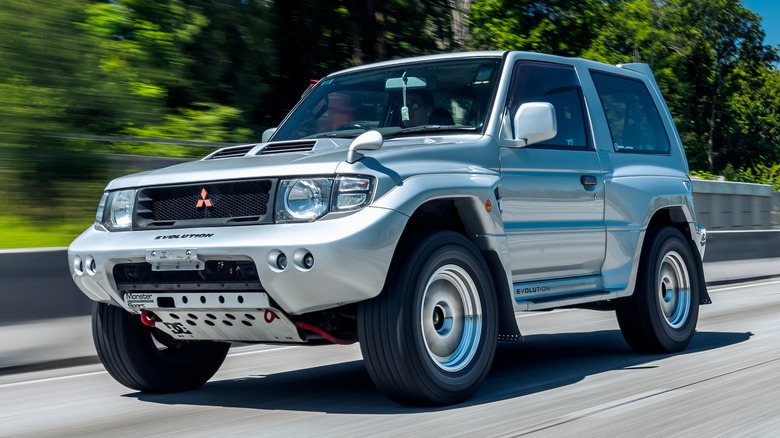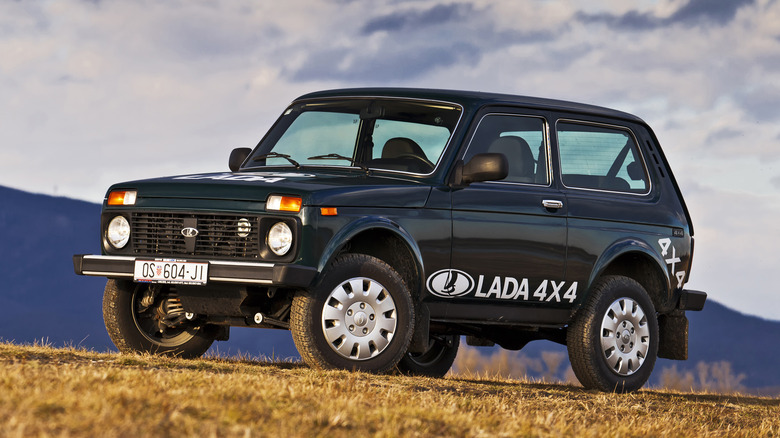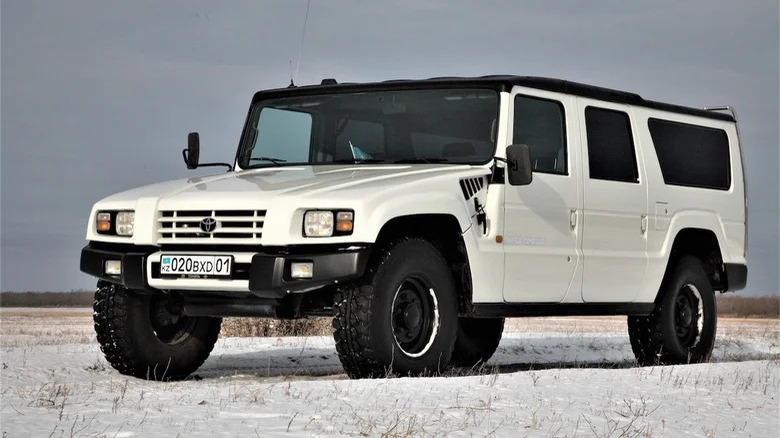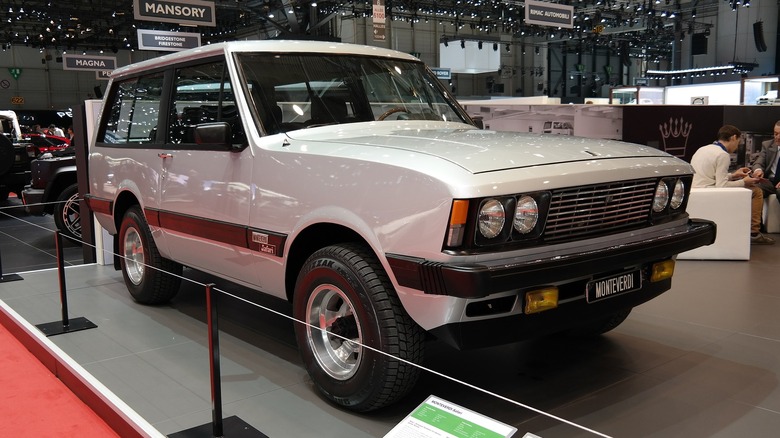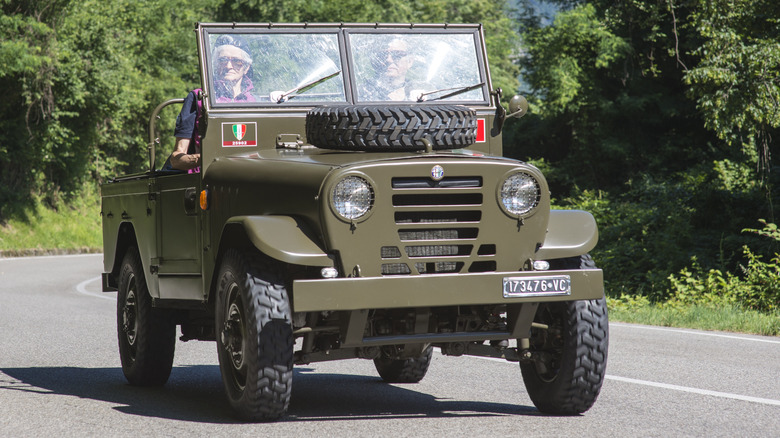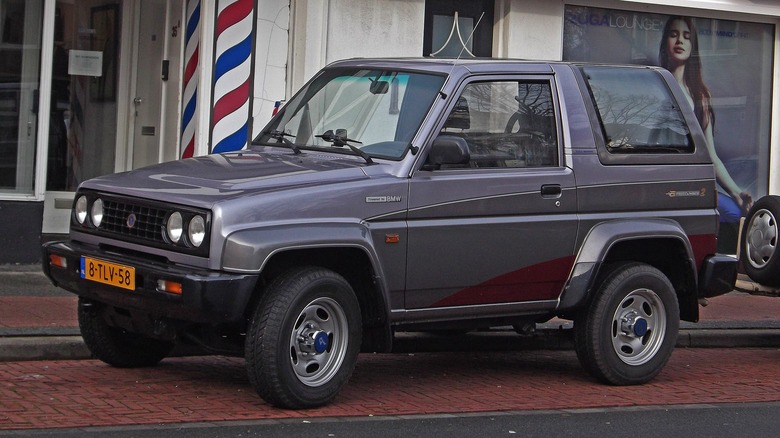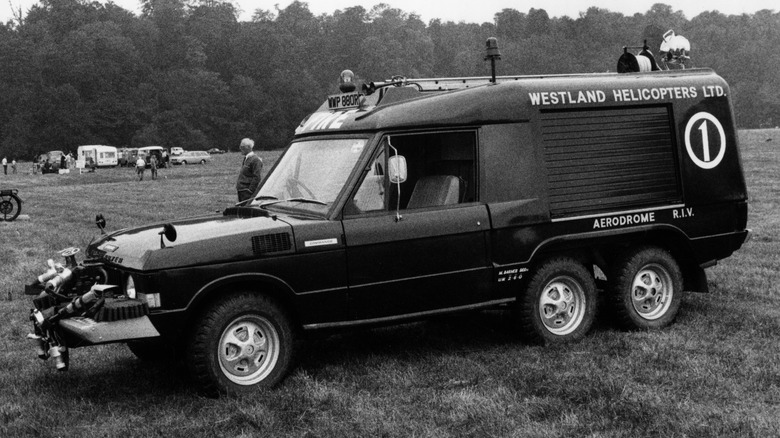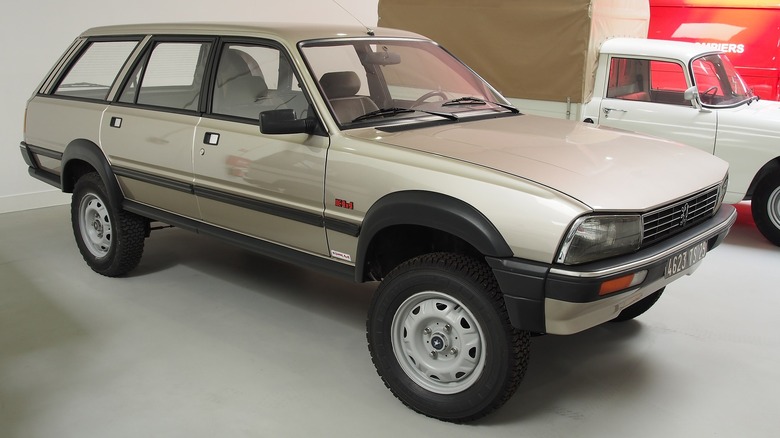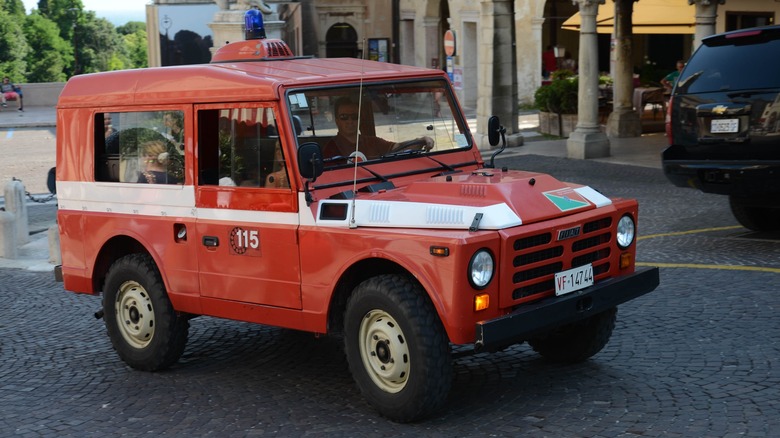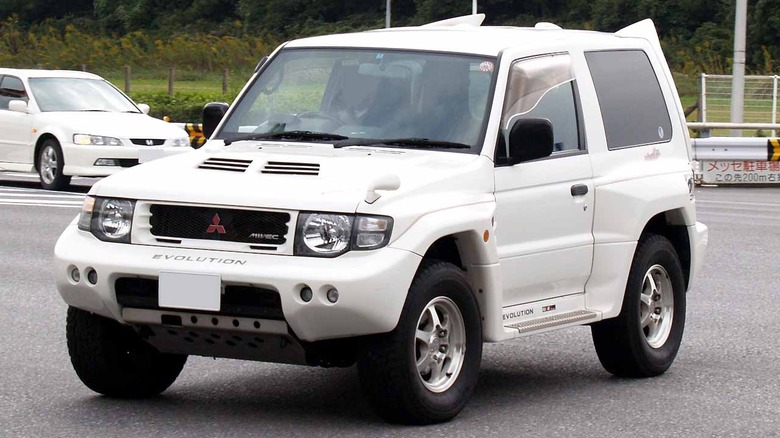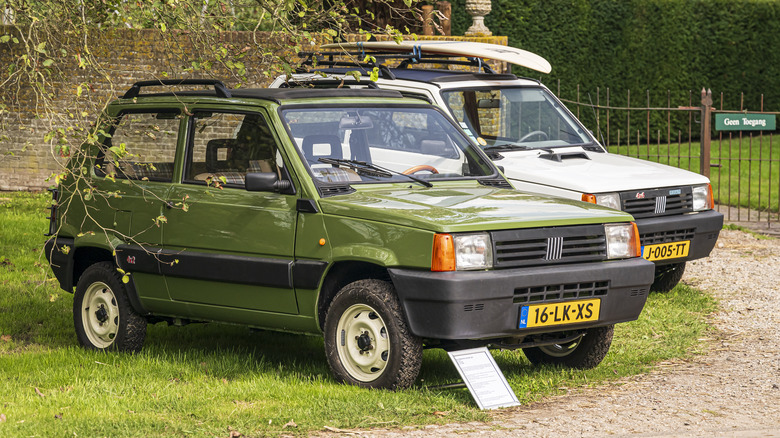10 Of The Coolest Foreign Off-Roaders That Can Now Be Imported To America
Jeeps, Land Cruisers, Land Rovers and suchlike are all stalwarts of the off-roading world for good reason. They're tough, easy to modify, and can be readily found on the used market. However, their popularity means that it's difficult to find one that's truly unusual, and if it is, it will usually come with a premium price tag. For those looking for something more unusual than any of those long-time favorites, there are plenty of options to choose from.
The best way to find something really unique is to look to overseas markets, where a wealth of off-roaders can be found that were never originally sold in America. Many of these vehicles are now old enough to be imported under the 25-year rule, and some of them won't break the bank either. There are many options to choose from, but we've rounded up a selection of our favorite rare but cool imports that can now be legally brought stateside.
Lada Niva
Arguably the quintessential Russian 4x4, the Lada Niva is a basic but tough off-roader designed to withstand the rough terrain of the country's vast expanses of wilderness. It has been in production since 1977 and has remained largely unchanged since then, which makes modern Nivas look hilariously outdated today. On the plus side, buyers can pick up a 25-year-old example knowing that it's essentially the same car as one just a few years old.
Originally developed through a partnership with Fiat, the Niva took the basic design of the Italian brand's 127 and toughened it up to survive the extreme winters of the Soviet Union. It proved to be a hit both within the country and internationally, as its simple construction meant it could be easily and cheaply fixed on the occasion it broke down.
The Niva became a common sight in many Soviet-aligned countries, both across Europe and further afield. That foreign popularity means that importable examples can still be readily found despite the present sanctions against Russia in the wake of its invasion of Ukraine. It's not particularly comfortable and it's certainly not fast, but few other off-roaders will command so much attention both on trail and asphalt.
Toyota Mega Cruiser
Toyota still has a reputation as a sensible brand, and the continued success of models like the Corolla and RAV4 means that reputation won't be changing anytime soon. However, delve a little deeper into its back catalog and you will find a surprisingly large history of weird and wonderful Toyota models that most people will have no idea existed. One such overlooked model is the Mega Cruiser, which was the Japanese equivalent of the Humvee.
It was originally designed for use by the Japanese military, but after seeing significant demand for a civilian version, Toyota decided to offer the SUV to the public in 1996. The civilian version featured a number of creature comforts over the military version, but its basic mechanicals — and therefore its off-road abilities — remained unchanged. Under the hood sat a 4.1L turbo diesel engine, while three diffs, full-time four-wheel drive, and four-wheel steering ensured there was virtually no terrain the Mega Cruiser couldn't handle.
It's thought that just over 100 examples of the SUV were produced before it was discontinued in 2001, and all of those were built in right-hand drive. Officially, the Mega Cruiser was only ever sold in Japan, but thanks to its popularity with well-heeled foreign off-road enthusiasts, examples can now be found all over the world. A handful of examples are known to have made their way to America, but this Japanese giant still remains a fleetingly rare sight.
Monteverdi Safari
Throughout its production run, the Monteverdi Safari remained relatively under the radar, and today it's been mostly forgotten by enthusiasts. Monteverdi was a Swiss marque founded by Peter Monteverdi, originally selling sports cars but later shifting into luxury off-roaders. After seeing the success of the Range Rover, Monteverdi was convinced that he could make his own SUV that was even more luxurious and didn't compromise on all-terrain ability. He developed the Safari, which was based on the International Harvester Scout but featured a custom body developed by Fissore, a coachbuilder based near Turin, Italy.
The Safari borrowed parts from a number of other high-end cars, fitting them to the SUV alongside a luxuriously upholstered interior that was a step above anything that Land Rover offered at the time. A range of powerful American engines were offered, including a Chrysler 440 V8 churning out over 300 horsepower.
Despite its charms, the Safari remained a niche model throughout its time on sale, with wealthy Middle Eastern clients reportedly being its main market. Examples that survive today are hard to find, and when they do appear for sale, they command significant sums. One example appeared at auction in summer 2024 with an estimate of around $100,000. Still, for buyers with a healthy enough budget, this is arguably the ultimate classic luxury off-roader, and capable of putting Range Rovers to shame.
[Featured image by Norbert Aepli via Wikimedia Commons | Cropped and scaled | CC BY 4.0]
Alfa Romeo 1900M Matta
Long before Alfa and Jeep were brought under the same ownership, the Italian brand had built its own version of the original Willys Jeep. It was created with the intention of winning a contract with the Italian military in the '50s but was unsuccessful, as commissioners preferred the simpler, cheaper Fiat Campagnola. The Matta reportedly drew the interest of several international parties including the British military, but in the end, a contract was never finalized.
Alfa ended up producing around 2,000 examples of the car for civilian sale, mostly with farmers or estate owners in mind. The car's rugged Jeep-based design was hardly revolutionary, but extras like the high-end shock-absorbing suspension ensured this was no run-of-the-mill agricultural vehicle.
Out of the original 2,000 units, it's thought that around 100 examples survive today. Many reside in Italy, where the Matta was originally sold, but a number of examples are known to be registered across Europe. Several have also been imported to America, where they can fetch anywhere from $30,000 to $50,000 depending on their condition.
Bertone Freeclimber
Italian coachbuilder Bertone is best known for designing sports cars and swooping grand tourers, but it's produced its fair share of unusual designs over the decades. One of the most unlikely designs that made it to production was the Freeclimber SUV, which was based on the Japanese Daihatsu Rocky. Unlike the regular Rocky, which was a budget-oriented workhorse, the Freeclimber was designed to be a luxury SUV, and featured an upscale interior and a range of BMW engines.
This was no simple badge engineering job — the Freeclimber was built in-house at Bertone's factory and featured modified bodywork to further differentiate it from its humble Japanese roots. The company churned out around 2,800 examples of the first-generation SUV between 1989 and 1993 before replacing the Freeclimber with a second-generation model, pictured above, that followed the same formula. That second generation would continue until 1995 and prove just as popular, with another 2,800 examples sold before production ended.
[Featured image by Dennis Elzinga via Wikimedia Commons | Cropped and scaled | CC BY 2.0]
Land Rover Range Rover 6x6 Carmichael
Arguably one of the coolest six-wheeled vehicles ever made, the 6x6 Range Rover produced by British coachbuilder Carmichael was very different from the luxury 6x6 vehicles favored by wealthy Middle Eastern sheikhs today. It was built mostly with commercial clients in mind, with around 400 examples thought to have been produced in total. Many of those would end up seeing service as all-terrain ambulances or fire trucks since they could operate in remote areas that would be unsuitable for most SUVs and, thanks to their extended length, could carry equipment and patients.
A number of examples were also built for individual clients, and these tended to be more luxuriously appointed than their commercial counterparts. While they're relatively rare to find today, at least in good condition, they're not exceptionally expensive given their history. One fully restored example appeared at a French auction in 2022 with an estimate of €40,000 to €60,000 (roughly $43,000 to $65,000 at the time), while an unrestored example sold in the UK in 2024 for £29,250 (around $38,000).
Peugeot 505 Break 4x4 Dangel
Dangel is a French off-road conversion specialist that today builds 4x4 versions of popular commercial vans from the likes of Toyota, Fiat, and Peugeot. The latter is one of its most long-standing partners, with the 505 Break 4x4 being one of its earliest — and coolest — models. The Break was the wagon version of the 505 and was sent to Dangel for conversion to off-road spec.
As well as fitting four-wheel drive, it also meant giving the wagon a lift kit, fitting appropriate tires and suspension, and installing locking diffs and a low-speed gearbox. A thorough transformation, then, and one that was entirely necessary, since the car was designed for use in remote parts of North Africa.
Around 500 examples of the 505 Break 4x4 were built by Dangel, and it's thought only a few of those survive today. They occasionally appear for auction and can fetch anywhere from $25,000 to $65,000 for the most pristine examples.
[Featured image by Alf van Beem via Wikimedia Commons | Cropped and scaled | CC0 1.0]
Fiat Campagnola
Born from the same military contract as the Alfa Romeo 1900M Matta, the original Fiat Campagnola was a simple but effective off-roader. It was instrumental in helping kickstart Italy's agricultural industry after the impacts of World War II, and it saw decades of service with the Italian military. The original iteration bears a resemblance to the Willys Jeep – this is no accident, as Fiat made no secret of the fact that its Campagnola design was heavily inspired by the American off-roaders that Allied troops had left behind. The Willys MB Jeep was considered the ultimate off-road machine, and Fiat aimed to replicate its success.
The first Campagnola was constructed in 1951, and in 1953, a diesel variant was also launched. Production of the vehicle continued until 1974, when Fiat unveiled a "Nuova Campagnola," pictured here, featuring a more modern chassis and sharing parts with the brand's contemporary passenger car lineup. This second iteration proved just as popular with both civilians and the military and remained in production until it was finally discontinued in the late '80s. One example even ended up as an official Popemobile at the Vatican.
Since most Campagnolas lived tough lives, examples in good condition are tricky to find today. A handful of examples from both generations have been imported into America in the decades since production ended, but most remain in Italy.
Mitsubishi Pajero Evolution
Ask most enthusiasts which car first comes to mind with the words "Mitsubishi Evolution", and the answer will likely be one of the legendary Lancer Evolution rally specials. For many people, the Lancer Evolution series still remains their defining image of the brand today. The Pajero Evolution applied a similar suite of rally-inspired upgrades as its iconic sedan siblings, but this time to the brand's everyday SUV.
Some variants of the Pajero were marketed in America as the Montero, although the Pajero Evolution was a long way from any Montero that could be found in dealerships. It packed a 275 horsepower V6 engine, a widened stance, and beefier tires and suspension to homologate Mitsubishi's Pajero racer for the Dakar Rally. It was produced in strictly limited numbers, with an estimated 2,000-2,500 rolling off the production line. A number of examples have since been imported to America, but buyers willing to handle the import process themselves can potentially find the car for lower prices in other collector markets like the U.K.
[Featured image by Comyu via Wikimedia Commons | Cropped and scaled | CC BY-SA 3.0]
Fiat Panda 4x4
It might seem like an unlikely off-roader, but the Fiat Panda 4x4 can tackle rougher terrain than many enthusiasts might think. It will do so in its own time though — the original iteration of the car featured a standard Fiat four-cylinder engine making less than 50 horsepower, making it amusingly slow by modern standards. The second and third generations of the car offered improved power and creature comforts, although American Panda enthusiasts can't import one for now. The second generation only launched in 2004, and the third generation remains in production today.
The Panda 4x4 celebrated its 40th birthday in 2023, with the brand having produced over 800,000 examples over that time. Its continual popularity in Italy and elsewhere in Europe means that there are plenty of importable examples to choose from. Those who prefer not to bother with the hassles of the import process are in luck too, as quite a few Panda 4x4s have already made it stateside and regularly crop up on auction sites like Bring a Trailer.
